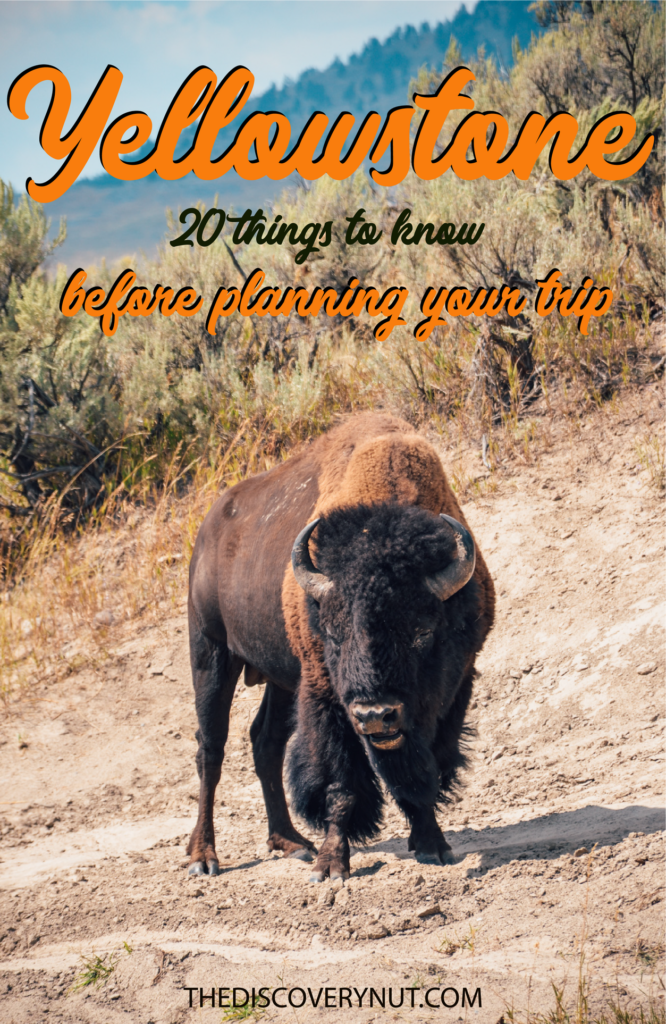A trip to Yellowstone is a bucket list item for adventurers from around the globe. The oldest national park in the United States, it boasts shooting geysers, bubbling hot springs, and free-roaming hoards of bison.
If you love adventure, perhaps you have a trip to Yellowstone on your bucket list. But before you pack bags, there are few things to know. As much as Yellowstone is beautiful, it can also be dangerous: wolves and bears roam the area. And the hot springs dominating the landscape can seriously hurt you or even kill you.
PRO TIP: Check out my suggested itineraries for multiple days at Yellowstone.
After traveling to Yellowstone, I put together my guide that will help you avoid mistakes on your trip and stay safe.
Here are my top tips for visiting Yellowstone National Park.
1. Keep the distance from animals
The wildlife that roams Yellowstone is one of the reasons so many people come here. Many photographers descend on areas of Yellowstone such as Lamar and Hayden Valleys to photograph bison, moose, and if they get lucky, even bears.
You don’t have to wait to get a sight of a wild animal. Bison in particular move around Yellowstone and it’s not uncommon to spot one crossing the road while you drive.
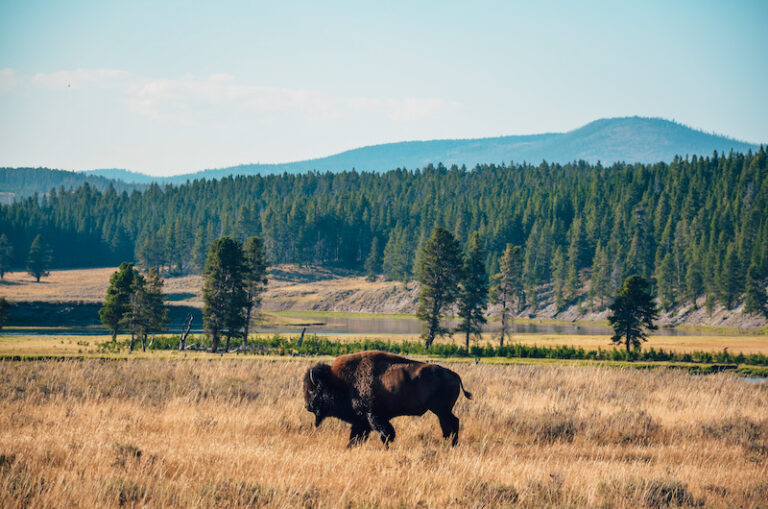
That’s when you have to be careful.
Bison might seem slow and docile, but they can be aggressive and unpredictable when they feel threatened.
Oh, and they can also run fast!
It’s recommended to stay at least 25 yards away from bison, and 100 yards from bears and wolves. When you see wildlife during your trip to Yellowstone, pull over to the side of the road, and take photos from a safe distance.
2. Carry a bear spray
Yellowstone is a bear country where you can spot a grizzly and black bear.
While you will not see as many bears as bison roaming around, a chance of a bear encounter is real in Yellowstone, especially if you go on a hike in less popular areas. This is why you should ALWAYS carry a bear spray when you walk around Yellowstone!
When possible, hike in groups of three or more people and make noise to avoid encounters with a bear (some hikers even carry bells on their backpacks to detract animals).
If you encounter a bear, never run from it! Slowly back away.
When camping, keep your food, trash, and toiletries in bear-proof containers that prevent the smell from coming out.
3. Take an organized tour when short on time
Yellowstone sprawls across more than 2.2 million acres encompassing Wyoming, Idaho, and Montana. The area covered by the park is larger than the East Coast states of Rhode Island Delaware combined!
From lush hills to valleys and geyser basins, this place is an outdoor paradise.
I recommend no less than three days in Yellowstone, but not everybody has enough time, as many people combine Yellowstone with other national parks in the region.
Taking one of Yellowstone tours is a good idea if you have from one to two days in Yellowstone. These guided tours will give you a good glimpse into the history, geology, and wildlife of the park at a slower pace.
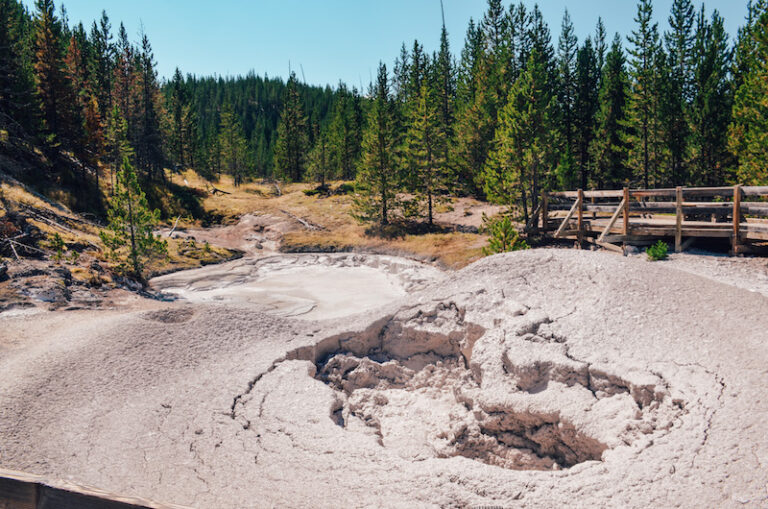
4. Stay in different areas of the park
While you can start your day in one area of the park, you may finish it in a completely different place. Since Yellowstone is so big, it makes sense to stay in several areas of the park, even if it means having to pack up every day.
Certain areas of Yellowstone can be two hours apart, and if you stay on the opposite side, you would have to drive that long to get back to your campsite or hotel.
Not something you want to do after a day of hiking and exploring.
Here are a couple of options for the best places to stay in Yellowstone:
West Yellowstone
West Yellowstone is a small town in Montana adjacent to Yellowstone National Park. Some of the popular hotels in West Yellowstone are Geyser Inn, Yellowstone Lodge, and Moose Creek Cabins.
Overall, West Yellowstone offers a good variety of accommodations and campsites. The trick is to book them early enough before prices go up.
Gardiner
Gardiner is a small town in Montana outside of the northern entrance of Yellowstone. When the campground and hotel at Mammoth Springs are full, many Yellowstone visitors head to Gardiner. Here are a couple of options for Gardiner:
1. Yellowstone Gateway Inn is a nice accommodation just two minutes outside the north entrance of Yellowstone. It’s also close to Gallatin National Forest.
2. Dreamcatcher Tipi Hotel – This authentic tipi will is one of the greatest places to stay in Gardiner. Gorgeous, cozy and authentic!
3. Yellowstone Hot Springs Cabins – Beautiful cabins inside and out that get rave reviews! Built in AirBnb style, they offer good privacy and tons of space.
Hotels in Yellowstone
Yellowstone has a number of hotels, however, compared to accommodations outside the park, they typically come at premium prices, especially during the high season. Just to give you an idea, you can expect to pay between $300-400 for hotels near a popular area such as Old Faithful around July and August.
Here is a breakdown of Yellowstone hotels and their location:
1. Old Faithful Inn – One of the most popular hotels at Yellowstone, Old Faithful Inn is located right near Old Faithful. While the price can be a bit high, it’s a great place, if you want a central location and be able to watch Old Faithful in the morning before crowds arrive.
2. Old Faithful Lodge – another lodge conveniently located near Old Faithful. Like other hotels in Yellowstone, it can get full very quickly, so don’t forget to book it in advance.
3. Mammoth Hot Springs – A hotel near the northern entrance of Yellowstone, Mammoth Hot Springs sits near stores, restaurants, and some of the most prominent historic landmarks of the park.
4. Canyon Lodge – located in Canyon village near Grand Canyon of Yellowstone.
5. Lake Village – located north of West Thumb, Lake Village has two hotels, Lake Hotel and Lake Lodge. It’s a good place to stay for your first night at Yellowstone, as you can go clockwise from here.
Camping at Yellowstone
Campgrounds at Yellowstone are available on a first-come-first-serve basis in Lewis Lake, Norris, Pebble Creek, Slough Creek, and Mammoth. Note that while more remote campgrounds such as Lewis Lake are less busy, popular ones such as Norris and Mammoth are almost always full during the high season.
If you plan on changing your campgrounds, make sure to arrive in the morning while the spots are still available.
5. Rent a car
You will need to rent a car if you are planning a trip to Yellowstone.
The pick-up location depends on your starting point, but it’s probably going to be one of the airports in the area. Many Yellowstone visitors fly into Salt Lake City, Idaho Falls, or Bozeman, some of the largest airports near Yellowstone that offer connections to major cities across the United States.
Another option is a smaller and more expensive airport at Jackson Hole near Grand Teton National Park.
If you travel during the high season (July and August), book your car ahead of time. I recommend Discover Cars that offer affordable rates and flexible conditions!
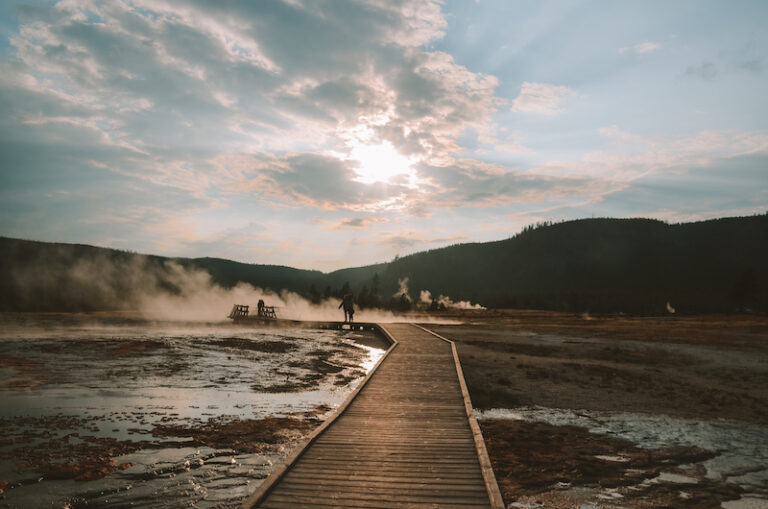
6. Stay on boardwalks
When you visit Grand Prismatic Spring, the Old Faithful and Geyser Hill, and Midway Geyser Basin, stay on boardwalks. Numerous visitors have been burned by the scalding water from Yellowstone’s hot springs, and some even died when they fell down or got too close to these thermal features.
7. Dress properly
Weather patterns within Yellowstone fluctuate greatly. When visiting the park, pack for multiple seasons as temperatures can drop at night and shoot up to the 90s during the day during summer.
The early spring season (from April to May) can have snow and colder weather, while the summer season that brings plenty of sunshine and warmer temperatures tends to be the busiest time at Yellowstone.
The fall season (September through October) is the least busy time in Yellowstone. Whether you visit the park during summer, spring, or fall, you need to bring several layers, good sunscreen, and comfortable hiking shoes.
8. Bring a good camera
Yellowstone is teeming with incredible biodiversity, history, and unique geologic features such as hot springs, geysers, mud pots, and fumaroles.
While you can always use your phone to take photos of Yellowstone’s incredible landscapes, I recommend bringing a camera with a wide-angle lens that will be able to capture high-resolution images in great detail.
PRO TIP: Make sure to leave your drone at home. Unmanned aircraft devices (or drones) are prohibited from all National Parks in the United States including Yellowstone. You can get a steep fine if a park ranger catches you flying one.
9. Do not feed wildlife
Feeding wildlife if prohibited at Yellowstone.
Human food is not only harmful to animals, it also encourages aggressive behavior and reliance on digging in trash cans around campsites that could lead to animals being euthanized. Always pack up and throw away your leftovers and put your food in bear-proof containers while you are on a trip to Yellowstone.
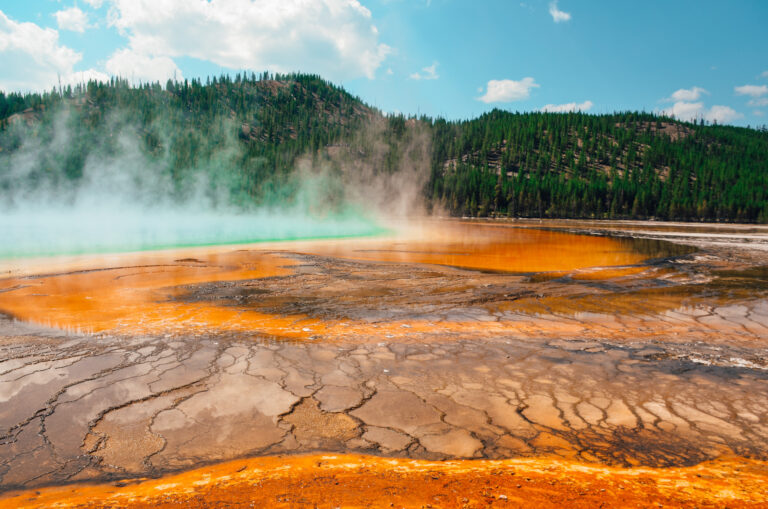
10. Tour Yellowstone early
Most visitors tour Yellowstone from around 10 a.m. to 4 p.m. It means that trails are going to get busy, and parking will be limited. Plan your activities early in the morning to avoid crowds. You will have to get up around 6 a.m. and be on your way around 7 a.m.
It is a good tactic for popular places such as Old Faithful and the surrounding area that always have thousands of visitors.
Noon is a good time to have lunch and hunker down until late afternoon or early evening when crowds recede, and you can tour the park again.
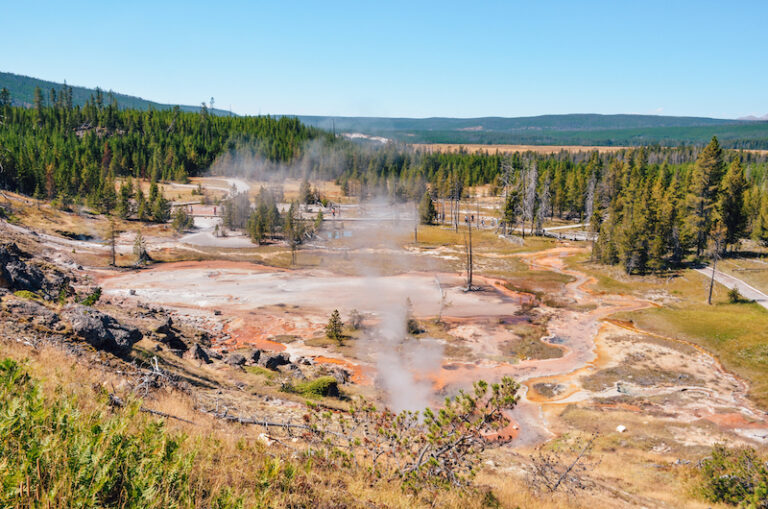
11. Take a hike
The most popular areas of Yellowstone, Old Faithful, Grand Prismatic Spring, Mammoth Hot Springs, and the Grand Canyon of Yellowstone do not require a lot of walking. Most landmarks in Yellowstone can be accessed by a 5-10 minute walk from your car unless the parking lot is full, and you have to park away from the trailhead.
This is why it’s such a great idea to take a hike and explore Yellowstone off the beaten path. Some of my favorite hikes in Yellowstone are Ice Lake and Gibbons Lake along the road between Norris and Canyon Village; Upper Falls and Lower Falls of the Grand Canyon of the Yellowstone.
Another great hike in Yellowstone is Mount Washburn and Bunsen Peak, a trail with an elevation gain of over 1,300 feet!
12. Don’t rely on your cell phone
Cell phone service is spotty or non-existent in many areas of Yellowstone. That’s why you should never rely on your phone when traveling through the park. When you enter Yellowstone, ask a park ranger for a map and if you want a detailed map of a specific hike or a landmark, print it out ahead of your trip.
13. Purchase America The Beautiful Pass
If you plan a trip to Yellowstone, you will probably visit other national parks in the area such as Grand Teton National Park in Wyoming or Glacier National Park in Montana. Each of these national parks requires a separate fee of $35. However, you can minimize the price by purchasing America the Beautiful Pass for $80 that provides access to all parks within the National Parks System.
This pass is a good investment if you plan on touring West Coast National Parks.
14. Recycle bear spray
If you are going to fly back home, you should know that bear spray is not allowed on planes. You also can not throw it in the trash. Yellowstone has designated locations where you can dispose of bear spray, and you can find them online.
15. Don’t forget about sunscreen
The sun can be strong at Yellowstone during summer. While you can buy sunscreen in stores inside the park, it’s going to cost a lot more than at a regular store. Make sure to purchase sunscreen ahead of your trip to Yellowstone.
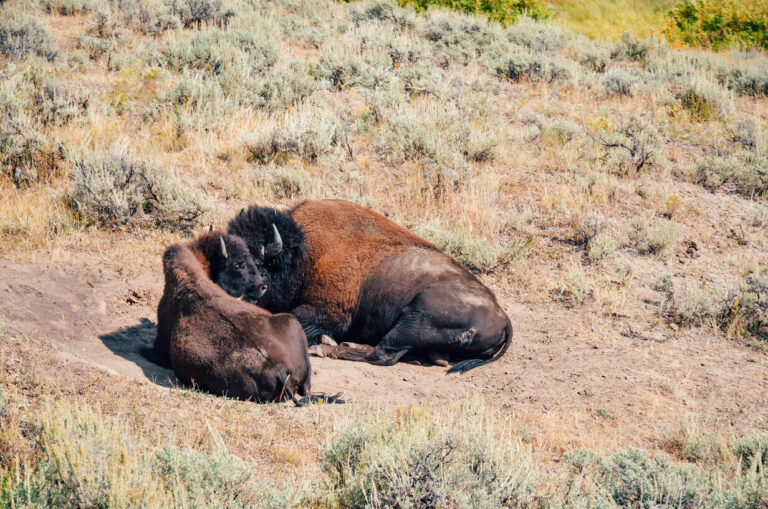
16. Watch wildlife
Lamar and Hayden valleys are some of the best areas for photographing wildlife. In Lamar Valley, you can spot deer, elk, bears, coyote, and bison. Bring binoculars if you want to spot wildlife in the distance and be patient: Many animals come out in the evening hours before the sunset, and that’s when you have the best chance to spot them.
17. Stock up on food
Food is expensive at Yellowstone, whether you go to stores or restaurants. To give you an idea, I ended up paying close to $5 for one oatmeal. Although there are several grocery stores and restaurants throughout the park, the food there will be generally more expensive than outside the park.
On top of it, Yellowstone is a busy park, and bringing your food eliminates the need to go to the busy stores, look for parking spaces and sit in traffic jams.
18. Fill up your tank outside the park
As you might expect, gas is pricey within Yellowstone, so make sure to fill up your car before entering the park.
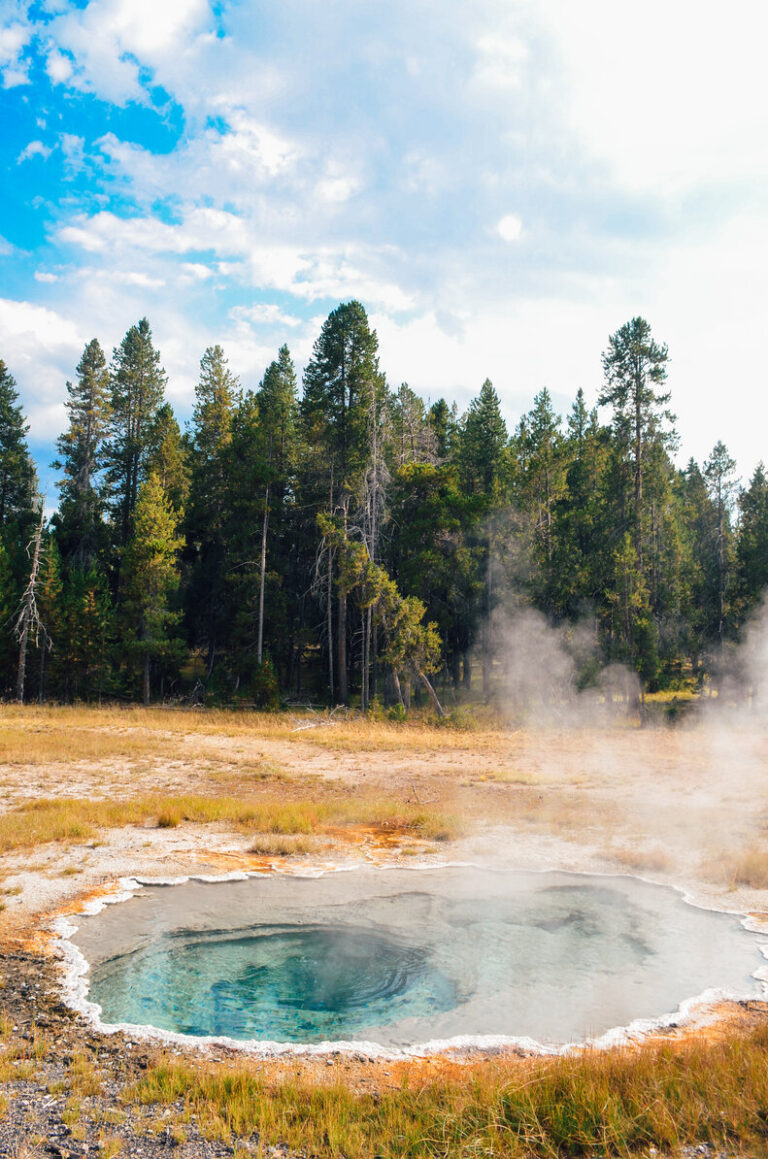
19. Take your time
You need time to see and appreciate Yellowstone. While you can hit all of the park’s highlights in about three days, I recommend spending 4-5 days at the park to do a couple of hikes, see landmarks and do some wildlife watching.
20. Look up at the stars!
Yellowstone National Park is located away from the major sources of light pollution and it boasts amazing starry skies. Walk away from your campground or hotel during the dark hours and look up to see the Milky Way on a clear night!
If you are going to walk in the dark, it’s a good idea to carry a flashlight, as lighting is kept to a minimum at Yellowstone.
Visiting Yellowstone National Park is an amazing experience. I hope you stay safe during your trip and have a lot of fun!
Disclaimer: This post contains affiliate links. At no cost to you, I might earn a small commission if you make a purchase through the links in this article.
